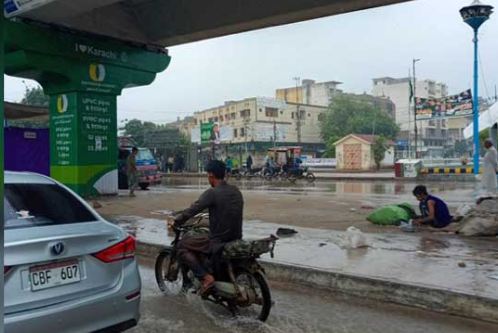KARACHI, SEPT 10 – Persistent monsoon rain battered Karachi from Tuesday into Wednesday, leaving large parts of the city paralysed as overflowing drains and swollen streams flooded homes and roads. The heavy downpour caused severe waterlogging, brought traffic to a standstill, and damaged key infrastructure across the port city.
Rescue 1122 spokesperson said over 350 residents were evacuated from submerged neighbourhoods in joint operations with the district administration, while Pakistan Army teams helped pull several families to safety.
Relief centres were set up and water rescue teams deployed as floodwaters entered dozens of residential areas including Saadi Town, Essa Nagri, Nasar Basti and Machhar Colony.
The rescue service reported that 15 children, one elderly man and four women were rescued from Lassi Para near Sohrab Goth, while two more people trapped near Lyari River in Gulshan-e-Iqbal were safely pulled out alive.
Authorities warned that rain is likely to persist through Wednesday night, with brief heavy showers forecast for parts of western and southern Karachi later in the day, keeping the city on high alert.
The flooding trapped residents inside their homes, caused severe waterlogging on key thoroughfares, disrupted traffic and daily routines, and triggered extensive rescue and relief operations by the city administration.
According to the Pakistan Meteorological Department (PMD), the maximum temperature is expected to remain between 27°C and 29°C, with humidity recorded at 92%. Winds from the southeast were blowing at about 15 kilometres per hour on Wednesday morning.
The monsoon system persists in the form of a depression centred 60 kilometres west of Karachi, which may turn into a low-pressure area in the coming hours, bringing more rain-laden clouds towards the city. The weather system is also affecting Jamshoro, Thatta, and Sujawal districts.
Sindh Chief Minister Murad Ali Shah toured multiple rain-hit areas, including Qayyumabad, Korangi Causeway and Shaheed Bhutto Road, to inspect drainage and rescue efforts.
He was accompanied by provincial ministers Saeed Ghani, Makhdoom Mehmood, and Chief Secretary Asif Haider, who briefed him on the operations. Information Minister Sharjeel Inam Memon also joined the inspection of Malir River.
The CM remarked that Korangi Causeway resembled a river and assured it would reopen once water from Malir River receded.
He directed the administration to keep citizens informed about developments at Malir River, Korangi Causeway and other critical areas, and instructed DIG East to ensure traffic flow across the city with police deployed for public facilitation.
The CM added that KMC, PDMA, Rescue, police and other agencies remained fully mobilised across Karachi.
Earlier, the rising water level in Thado Dam caused flooding near the M-9 Motorway, close to Jamali Bridge, with authorities confirming that the water had reached the carriageway. Officials later clarified the overflow was from the Lath River, not the dam itself.
Karachi commissioner dispatched teams on the chief secretary’s directions, and a section of the motorway’s median wall was broken to allow the water to pass, as directed by Sindh Chief Minister Murad Ali Shah. He also ordered immediate clearance of the road to restore traffic flow.
Sindh government spokesperson Nadir Nabeel Gabol said 30 pumps had been deployed for drainage, with more being installed.
He explained that Shaheed Bhutto Road, still under construction, had been cut to give water a passage, adding that there were no cracks on the road and no cause for concern. He further said the project was being carried out by an international firm and negligence would not be tolerated.
Karachi Mayor Murtaza Wahab, who inspected waterlogging at Nagan Chowrangi, said rescue teams were deployed across the city and four relief centres had been set up.
Several neighbourhoods — including FB Area, Shafiq Colony, Essa Nagri, Nasar Basti, Sohrab Goth, Hasan Nauman Colony, Machhar Colony, Lassi Para, Yaar Mohammad Goth, and Saadi Town — reported water entering homes after streams overflowed. Videos circulating online showed Saadi Town streets under water, contradicting earlier claims that the reports were fake.
A screengrab taken from a video shows a neighbourhood in Saadi Town submerged in water on September 10, 2025. — Geo.tv
A screengrab taken from a video shows a neighbourhood in Saadi Town submerged in water on September 10, 2025. — Geo.tv
Rainfall data from the PMD showed Surjani Town received the heaviest downpour at 130 millimetres, followed by North Karachi (72mm), Korangi (71), Defence Phase VII (70mm) and Gulshan-e-Hadeed (69mm). PAF Faisal Base recorded 55mm, Nazimabad 54mm, Keamari 52mm and Saadi Town 51mm.
Gulshan-e-Maymar saw 48mm, Orangi Town 47mm, the Airport 47mm, M-9 Motorway 45mm, University Road 44mm and PAF Masroor Base 41mm. The lowest rainfall was measured at Jinnah Terminal with 29.8mm.
Traffic police shut the Korangi Causeway and several connecting roads, including Godam Chowrangi to Mehmoodabad, due to the strong current of water from the Malir River, diverting traffic towards Jam Sadiq Bridge and Qayyumabad.
A road from Teen Hatti to Guru Mandir collapsed due to faulty sewerage work, worsening traffic problems, while roads near Chowrangi Chowk and Jahangir Road were also submerged.
Waterlogging disrupted traffic at multiple spots including the National Stadium, Civic Centre, NIPA, Expo Centre, Kala Pul, Guru Mandir graveyard, Shahrah-e-Faisal, Korangi, Qayyumabad, Liaquatabad, Landhi and Dawood Chowrangi. Traffic police said personnel were on the ground working to regulate vehicular movement despite severe pressure.
The Karachi commissioner announced the closure of all educational institutions on Wednesday, while Dow University Hospital postponed all examinations scheduled for the day. Revised dates will be announced later.
Meanwhile, MQM-Pakistan convener Dr Khalid Maqbool Siddiqui criticised the Sindh government and local bodies, calling the situation “evidence of incompetence and negligence.” He warned of possible human and financial losses as Lyari and Malir rivers swelled into residential areas and blamed encroachments along storm drains on the provincial authorities.
He further alleged that the collapse of Bhutto Road, built with billions of rupees, symbolised corruption and said Karachi had been damaged by “non-local” governance.
Officials said water levels in rivers and streams were gradually falling, with the flow from the Kirthar Range weakening. The water level at the Malir River bridge on M-9 dropped from 12 feet to 8 feet, and authorities expressed hope that the situation would be under control a few hours after the rains stopped.
Rescue officials confirmed one fatality after a man was electrocuted at a puncture shop in North Nazimabad. Separately, a woman’s body was recovered from Gadap Nadi, while search operations are under way for three others reported missing.

















